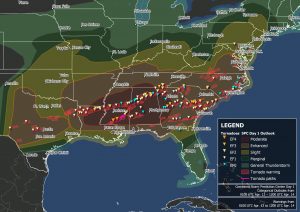This post is part of a series on the convergence of COVID-19 and weather/climate. Each post covers only part of the complex, evolving situation we all are trying to prepare for, respond to, and learn from. Therefore, any recommendations should be considered within your individual geographic, economic, and social context.

Ferdouz Cochran and the Convergence Team. April 27, 2020
A severe weather outbreak on April 12th and 13th across the Southeast caused many to seek shelter, report damage, and close facilities, including drive-thru COVID-19 testing sites. A total of 16 tornadoes were confirmed in NC and 25 in SC where 8 EF 3+ tornadoes occurred overnight. Hurricane-force wind gusts impacted numerous counties, and thousands remained without power as repair crews worked diligently while wearing masks and maintaining physical distance. The reality of COVID-19 guidelines intersecting with severe weather outbreaks and impacts has caused many to reimagine actions needed to stay safe. While varying steps for preparedness and recovery are being taken at the local level, a consistent message has yet to emerge across regions and states. Therefore, the Convergence team is bringing together some initial information for the public to consider across the Southeast and beyond.
Combining guidance from the NWS, AMS, CDC, Red Cross and other sources, we have identified a few steps below to take for both preparedness and recovery from severe weather during the COVID-19 pandemic. While we have written these initial steps for the public, we believe they may also inform emergency managers and other professionals aiding in setting up shelters and coordinating recovery efforts.
Preparedness
Creating or revisiting your severe weather plan is the foundation for staying safe. Your plan should include the following actions to be completed weeks, days and hours before a severe weather event.
- Stay informed through local news and public alert/warning systems. Make it a daily habit to be aware of weather forecasts by listening to your local news, tuning into social media, and signing up for severe weather alerts. Counties are often a good source for disaster/emergency preparedness information, so sign up for your County news feed or public alert/warning system. For example, OCALERTS in Orange County, NC, keeps the public informed about severe weather, road closures, utility emergencies, neighborhood evacuations, and other critical news.
- Confirm your place to shelter. Decide on a safe place to shelter with sturdy walls, away from windows, and maybe enough space for physical distance in your home, business or community. If you need to seek shelter outside of your home or business, identify your shelter location and make sure it is currently operating as a shelter (check these and other city and county websites: Red Cross, NC, SC, FL). Due to the pandemic, some buildings – schools, community centers, sports facilities – that usually operate as shelters are closed. In addition to closures, keep in mind that there may be separate shelters for those who have COVID-19, related symptoms, or known exposure, and those who don’t. Now is the time to find out if this is a possibility in your area. Some local governments and organizations have proposed utilizing empty hotels and university dorms as shelters for providing more compartmentalized spaces to address COVID-19 physical distancing needs.
- Prepare to shelter in place for two weeks. Whether you shelter at your home, business, or a public shelter, be prepared to be there for 2 weeks given the current quarantine time for sudden symptoms or exposure to COVID-19. If you can shelter at home, your usual emergency preparedness kit will need to have a 2-week supply of food, water, medications and other necessities, plus a thermometer. If preparing a 2-week supply of these necessities is cost-prohibitive to your family, find your local food bank through Feed America or local food pantry through foodpantries.org. If you take shelter in a public location, it is helpful to have a packed bag or car trunk ready with at least a 3-day supply of your most basic necessities and the following: cloth masks, disposable gloves, soap and/or hand sanitizer, and disinfectant wipes. Some shelters may provide these supplies, but it is better to be prepared with your own. Up-to-date copies of your medical and insurance documents are even more important during this pandemic, and you will want to revisit your contact list for family and friends who are not in high-risk groups for COVID-19. Finally, adding or updating contact information for disaster/emergency assistance to your list before severe weather arrives can help you feel better prepared. In addition to the disaster/emergency assistance websites listed below by state, you may want to become familiar with the Voluntary Organizations Active in Disasters (VOAD) in your area who can provide resources for recovery, including spiritual and mental health support.
Recovery
Depending on the damage to your home/business/shelter and whether you or anyone around you is injured, you will need to keep in mind the following after a severe weather event (while continuing to listen to weather updates and news).
- Leave Repairs and Clean-Up to the Professionals. During this pandemic, it is even more important to practice patience and leave any repair and clean-up needs to the professionals or disaster assistance programs. This is not the time to walk through debris, climb up on roofs to remove tree limbs, or wade through flood waters. Everyone should avoid the possibility of suffering a post-disaster injury and having to go to the hospital. Stepping on a nail or falling off a ladder now means competing with medical and professional resources otherwise dedicated to COVID-19 patients.
- Follow CDC guidelines with Clean-Up and Repair Crews. If any building structures, equipment, or utilities have been impacted, contact companies to request repairs and have the utilities shut off if there is perceived danger. With all repairs, debris clean-up, and construction crews, make sure everyone protects themselves, wears a mask, and maintains physical distance. If repair crews or other individuals need to enter a home/business/shelter, also make sure everyone communicates whether anyone in the building has COVID-19, related symptoms, or known exposure, and disinfects any common surfaces that have been touched without clean gloves.
- Get virtual assistance. If your home or business has been severely damaged, you may need to seek disaster/emergency assistance. Under physical distancing orders, organizations such as the Red Cross have been using virtual platforms to connect with people instead of doing so in person. All shelters should have reliable WiFi and computers or smart devices that are routinely disinfected for occupants to contact disaster assistance programs, insurance agents, etc. and fill out necessary forms online. Information on disaster assistance and recovery can be found on state government pages, such as in NC, SC, AL, FL, GA, and VA. If you experience homelessness due to a severe weather event, the CDC has provided additional information to consider during the COVID-19 pandemic.
If you or someone you know has experience dealing with severe weather impacts and disaster assistance during the COVID-19 pandemic, we would be interested in hearing from you. Please send any stories or thoughts related to this post to fvc@unc.edu and we will try to incorporate your local knowledge in an updated or future post in our COVID-19 and weather/climate series.

